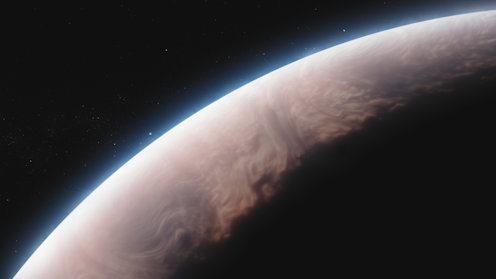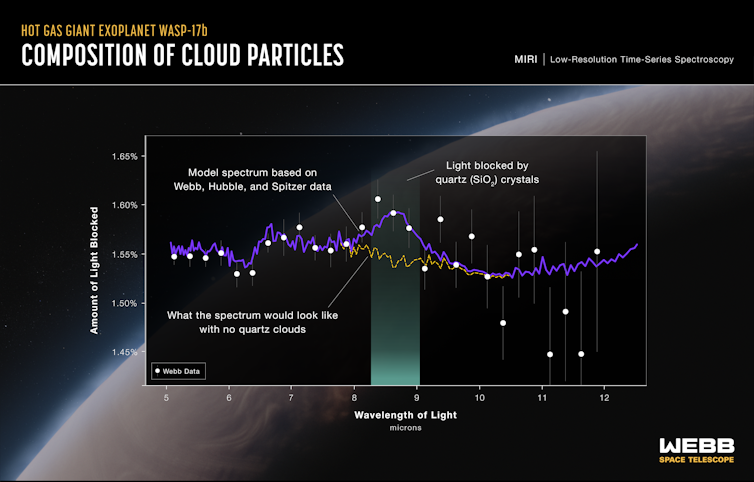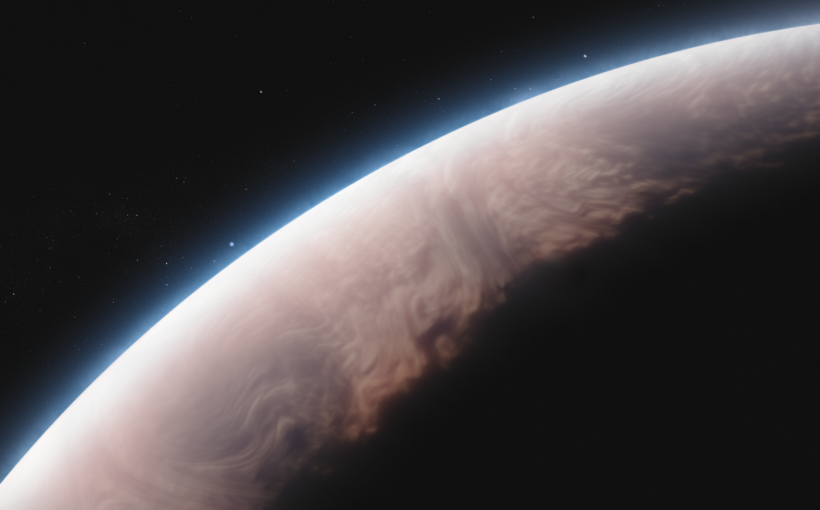
data gathered by Mid-Infrared Instrument (MIRI) and other ground- and space-based
telescopes, including the Hubble and Spitzer space telescopes. NASA, ESA, CSA, Ralf Crawford (STScI)
Quartz, also known as silica, is everywhere. This mineral is in the screen of the laptop or phone you’re reading this article on. It’s used to make computer chips, which are in everything from medical equipment to washing machines. It can be melted to produce glass.
Chemically, quartz is silicon dioxide: one silicon atom attached to two oxygen atoms. It’s a major component of the Earth’s crust, the ground beneath our feet.
This remarkable material has now been discovered floating in the atmosphere of a giant planet 1,300 light-years from Earth. This planet is called WASP-17b and belongs to a class of planet known as a “hot Jupiter”. WASP-17b is an exoplanet, which is a world orbiting a star that’s not the Sun.
The new study provides an important insight into the sometimes extreme and unfamiliar conditions present on worlds around other stars. We think of quartz as a hard substance, but the heat and pressure on WASP-17b can transform this mineral into a gas. The crystals then form out of this gas in the upper atmosphere.
Much like Jupiter, it’s composed mainly of hydrogen and helium. However, it orbits close to its parent star, completing a full circuit (a year on WASP-17b) in just 3.7 Earth days. The proximity to its star super-heats WASP-17b to temperatures of over 1,500°C (2,700°F). This temperature is so high that most materials, such as rocks or ice, will exist on WASP-17b only as gases.
We made observations of the planet using Earth’s largest space telescope, the James Webb Space Telescope (JWST). We looked at WASP-17b as it passed in front of its star from our point of view, a phenomenon called a transit. We then measured the starlight as it filtered through the planet’s atmosphere.
By breaking up that starlight into different wavelengths, we could see changes in how the atmosphere absorbs and interacts with that light. Each atom and molecule in the atmosphere imparts a unique fingerprint on the light, and we can use computer models to disentangle these fingerprints, linking them to particular chemical compounds.
Extreme conditions
Using JWST’s Mid-Infrared Instrument (MIRI), which measures light at infrared wavelengths, we revealed evidence for very tiny quartz crystals (nanocrystals) forming high-altitude clouds in the atmosphere of WASP-17b.
The pressure where the quartz crystals form, high in the atmosphere, is only about one-thousandth of what we experience on Earth’s surface. Combined with the temperatures of around 1,500°C, the conditions allow solid crystals to form directly from gas, without going through a liquid phase first.
This shows us that other planetary systems like this one, for example, in which gas giant planets orbit close to their parent stars, can have quite different characteristics to our Solar System.

The fine quartz crystals in the atmosphere of WASP-17b, which measure just one millionth of a centimetre, can help us unravel more information about this exoplanet and the nature of its atmosphere. Potentially, it could provide us with a detailed understanding of the planet’s chemistry.
We have previously detected silicates in the atmospheres of stars, astronomical objects called brown dwarfs and giant young exoplanets. However, these are often in the form of magnesium silicate and not pure silica. Silica can take on many forms depending on the additional atoms of material that contaminate it, slightly changing its properties.
Instead, on WASP-17b, we are seeing the likely building blocks of silicates in the form of tiny “seed” particles of pure silica absorbing and scattering the light, causing a spike in our measurements.
We combined these measurements with those from the Hubble Space Telescope, which measured the planet at optical rather than infrared wavelengths. When we fed the data into computer models, they told us the atmospheric particles are just nanometres across, 10,000 times smaller than the width of a human hair.
The prevalence of silicates throughout the universe suggests they should be there in all exoplanets in some form or another, but in the exoplanets that can be most easily examined with current tools they have previously eluded our detection.
While exoplanets have captured the imaginations of scientists and the public alike, of the some 5,500 known today, only a fraction can be explored in detail. But advanced telescopes such as JWST are allowing us to find out more than ever before about worlds located tens, hundreds and thousands of light years away.
![]()
Hannah Wakeford is an Associate Professor at the University of Bristol and receives funding from UK Research and Innovation (UKRI) under the UK government’s Horizon Europe funding guarantee formerly ERC Starting Grant (grant number EP/Y006313/1). HRW acknowledges the significant harm caused to members of the LGBTQIA+ community in the Department of State and Nasa, while under the leadership of James Webb as Under Secretary of State and Nasa Administrator, respectively.



